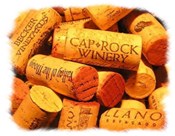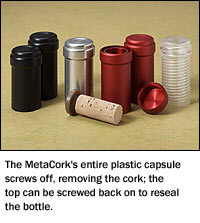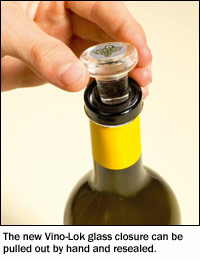
|
that plug of bark! ......is the Cork Age over?
By: Thomas M. Ciesla |
|
| |
|
|
Wine has a love-hate relationship with oxygen. During the winemaking process, oxygen is the devil for a vintner. Too large a surface area exposed to oxygen inside of a barrel will ruin the wine. That's why vintners are constantly “topping off” barrels during fermentation to keep the amount of wine exposed to oxygen as small as possible. For the consumer, however, oxygen is the wines friend – at least temporarily. We've all heard about opening a bottle of wine in advance to “breath”, or swirling a glass of wine to allow oxygen to mix with it and release a good “nose”. Once the wine is exposed to the atmosphere, however, things begin to go down hill in a hurry. Oxygen once again becomes the wine's enemy.
So the concept of storing wine is simple: a durable container with a seal to keep oxygen out. For over 300 hundred years, the preferred gatekeeper against oxygen has been the cork stopper. Why? Well, quite simply, there was nothing better available. But, after three centuries, wine is once again being ruined in the bottle -- the age old problem of storing wine has returned.
CORKED WINES! You've probably heard the term somewhere along the line, even if you're not a devoted wine drinker. The term refers to a bottle of wine that has that musty, moldy taste. The culprit of corked wine is TCA (2,4,6-trichloroanisole), a fungus that's found in cork. No one knows for sure how cork becomes contaminated with TCA, but cork-processing techniques are the likely source. Estimates of “corked” wines range from 5-10 % of all wine production. Now, this may not seem like that much, but when you consider that collectively we produce around 17 billion bottles of wine each year, even the low-end estimate represents a substantial loss of product. Corked wines occur at a rate that would not be tolerated by any other industry. The effects of TCA tainting range from the modest levels where the wine is robbed of fruit flavors, to high levels that impart a wet newspaper odor, making a wine quite undrinkable. So if cork fungus has been around as long as cork, why all the fuss within the last few decades? According to some winemakers, it's the recent advancements made in winemaking. As modern improvements have made wine better, even small amounts of TCA tainting become readily apparent. Ironically, while winemaking has dramatically improved, cork production has remained basically the same for the last 300 years. Frustrated with cork producer's inability to solve the TCA problem, winemakers looking for alternatives began experimenting with synthetic corks. These offered a TCA-free solution and currently make up around 9% of wine closures used in the industry. Though less expensive than natural cork, synthetic corks are not without problems: they resist some types of wine openers, and are often difficult to extract, or spin freely with every turn of the corkscrew. Winemakers quickly realized that synthetic corks were not the final solution to the perfect bottle closure.
|
 The Stelvin Screw Cap Closure |
SCREW IT! The screw-cap was invented by an Englishman around 1889 and was used as a wine closure as early as the 1940s by the Gallo wine company. The Stelvin screw-cap enclosure was created by the French firm Pechiney and adopted by the airline industry in the 1970s. In the late 1980s winemakers in Australia and New Zealand experimented with the Stelvin, but abandoned the effort to due poor acceptance. Then, as wine production increased around the world straining cork supplies, and spiraling incidents of TCA contamination created a renewed interest in the screw-cap. Today, Australian and New Zealand winemakers are moving en masse to screw-caps and increasingly are being joined by winemakers in California and even France, though the French have been somewhat reluctant to make the turn. The Swiss embraced screw-caps for their wines decades ago and today the closure is used on 70% of Swiss wines. Increased interest in screw-caps for mid-to-premium wines has created alternatives to the 'Stelvin closure'. The Stelvin screw-cap is technically known as ROPP – Rolled On Pilfer Proof, as opposed to the TOPP style – Torqued On Pilfer Proof. What's the difference? The TOPP enclosure is actually a sheath that twists off and hides the threads of the screw- cap, providing a more aesthetic look. Aesthetics are a big concern for winemakers, who while trying to break a centuries old tradition, also want customers to accept the new enclosures.
|

|
Metacork is a new technology that combines traditional cork with screw-caps, often referred to as a 'twist capsule'. The unique design has a built-in cork anchor that allows you to remove a cork or synthetic stopper with nothing more than a few twists of the capsule. Another twist on non-cork closure comes from Australian inventor Conor McKenna, called the ZORK. It is similar to a crew cap in the way it seals and it is made of material that won't taint the wine. The ZORK snaps on to the glass band found on traditional wine bottles. Once the aluminum seal is broken, a plunger is pulled out by hand, making that satisfying "pop." The plunger, which is similar to those used on inexpensive Ports, allows the bottle to be resealed after opening. The Alcoa Company has taken this concept a step further by creating a completely inactive glass stopper to reseal the wine. The product called Vino-Lok, is made of glass and fits into a wine bottle the way a decanter stopper does. |

|
Is there a screw-cap in your future? In the October issue of Food & Wine magazine, Robert Parker offered 12 bold predictions regarding changes in the world of wine. In prediction number five, Parker states, "I believe wines bottled with corks will be in the minority by 2015. Stelvin, the screw-cap of choice will become the standard for the majority of the world's wine." Parker isn't alone in his belief, Robert Smiley, a University of California wine economist also feels that in 10 years we won't be using corks, "It's not a quality solution to a long-term problem." Large hurdles still remain in separating the look of wine packaging from the inferred quality of the wine inside. There's also the power of tradition and human resistance to change. We like the sound of the cork popping, and we like the ritual of using the corkscrew. Some wine retailers – the other part of the acceptance equation – are not fans of the screw-cap, they think they cheapen the look of the wine and remove the mystery afforded with a cork. Building support for the screw-cap is like building a four-legged chair, all the legs: winemaker, retailer, restauranteur, and consumer must work together.
A Texas Twist? And what of Texas winemakers, are they ready to do the twist? Well, maybe someday but not in the near future. For some Texas winemakers, like Caris Turpen of Lightcatcher Winery, tradition and presentation are important, "We believe corks lend a specific and irreplaceable aspect of 'the culture of the table'. We think screw caps fit a certain type of wine style and might gain more recognition over the coming years, but we will not switch to them." Besides the aesthetic issues of a screw-cap is the question of wine quality; it's too soon to know if wine will be able to age well with this type of closure. Edward Manigold, owner/winemaker at Spicewood Vineyards shares that concern, "The major issues for screw caps are how long will the wine last and what is it's ageing potential?" Besides ageability, it's important to point out that screw-caps have their own problems. A screw-cap leaks more readily than a cork, and the metal caps can get banged up, sometimes to a point where the bottle can't be opened. In addition, screw-caps can be sabotaged by simply stabbing it with a knife. As California wineries experiment with screw-caps, Texas wine makers are likely to take and wait-and-see approach. Tim Dodd of the Texas Wine Marketing Research Institute knows of no major programs within the Texas wine industry to convert to screw-caps, though he believes a few of the larger wineries, "are considering the closure." Ultimately, making the switch to the screw-cap closure is a financial decision. In Texas, where most wineries are small, spending $75,000 on a specialized bottling line for a portion of your product can be prohibitive. Raymond Haak, owner/winemaker of Haak Vineyards sums up the cautious approach to the closure, "My guess the reason is that it takes big money to install new bottling machines for screw-caps and that eliminates most of the Texas wineries." Robert Parker's prediction may be realized by the winemakers 'Down-Under', but for the Texas wine industry, Raymond Haak's crystal ball is probably more accurate. And what about the grandfather of the screw-cap – Gallo Winery? They're studying the issue, but have no immediate plans to use the closure on their premium wines. How's that for irony?
|
